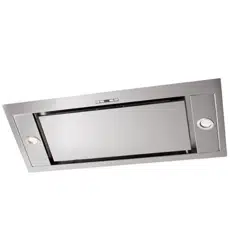Loading ...
Loading ...
Loading ...

The symbol on the product or on the packaging label on the carton indicates that the appliance should not
be treated as domestic waste, but should be delivered to a suitable electric and electronic appliance recycling
collection point. Follow local guidelines when disposing of waste. For more information on the treatment,
re-use and recycling of this product, please contact your local authority or domestic waste collection service.
INSTALLATION INSTRUCTIONS
Any electrical work must be undertaken by a qualied electrician. It is dangerous to alter specications in any way.
Ensure that all packaging, both inside and outside the rangehood, has been removed before it is used.
After installation, please dispose of the packaging with due regard to safety and the environment.
Note: Ensure you have read the warnings for installation on page 6.
•ElectricConnection
The appliance has been manufactured as a class II, therefore no earth cable is necessary.
The plug must be easily accessible after the installation of the appliance.
If the appliance is equipped with power cord without plug, a suitably dimensioned omnipolar switch with 3
mm minimum opening between contacts must be tted between the appliance and the electricity supply in
compliance with the load and current regulations.
The connection to the mains is carried out as follows:
BROWN = L line
BLUE = N neutral
• If a connection tube composed of two parts is used, the upper part must be placed outside the lower part.
Do not connect the rangehood exhaust to the same conductor used to circulate hot air or for evacuating fumes
from other appliances generated by other than an electrical source. Before proceeding with the assembly
operations, remove the anti-grease lter(s) (Fig.2-3) so that the unit is easier to handle.
- In the case of assembly of the appliance in the ducted version prepare the hole for evacuation of the air.
• We recommend the use of an air exhaust tube which has the same diameter as the air exhaust outlet hole.
If a pipe with a smaller diameter is used, the eciency of the product may be reduced and its operation may
become noisier.
Warning: Failure to install the screws or xing device in accordance with these instructions
may result in electrical hazards (see technical data if supplied).
•Installation
The following instruction should be followed to carry out the correct installation of the rangehood.
1. Mounting of the rangehood on the lower side of the cupboard.
2. Selection of the version (extraction or ltration).
3. Before starting to x the rangehood, disconnect the anti-grease lter for easier appliance handling:
- Open panel B as shown in Fig.2.
- Pull handle C as shown in Fig.3.
• Fitting the rangehood into the lower part of the wall cabinet
For all measurements relating to the rangehood, please refer to Fig.4.
Before xing the rangehood to the lower part of the cabinet, the following steps should be performed:
1. Remove the 4 screws E xing the two rangehood lamps H (RHS and LHS) in place as indicated in Fig.5A.
2. Remove the lamps H and disconnect the connectors W of the lamps to make installation easier, as indicated
in Fig.5B.
3. Make sure the thickness of the cabinet falls within the range of values listed in Fig.5C. Fit the rangehood in
the cabinet (Fig.6) and make sure the 4 springs are xed in place well. Fix the rangehood to the cabinet securely
by using a screwdriver to tighten the screws M until the appliance is ush with the cabinet (Fig.6).
4. Connect the connectors W of the lamps again and reinstall the lamps H xing them with the 4 screws E that
were previously removed.
•DuctedInstallation
When installed in this way the appliance expels fumes outside, either through a perimeter wall or through
existing ducting. It is therefore necessary to purchase a non-ammable air exhaust tube (not supplied) which
complies with all current legislation and connect it to ange N (Fig.1B).
- 7 -
Loading ...
Loading ...
Loading ...
